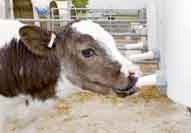Careful calf management brings dividends

Dairy farmers could dramatically reduce their replacement rates and boost output by more careful youngstock management. Olivia Cooper reports
Heifer replacements are a major cost to farming businesses but closer attention to detail in the early years could yield significant benefits.
In fact, calving heifers at 24 months instead of 28 could slash replacement rates from 29% to 23%, due to lower mortality and greater longevity, according to speakers at a recent DairyCo farm walk, hosted by Wills Bros, Pawton, Cornwall.
Healthy calves with good growth rates were key to earlier puberty and greater lifetime production, said Rob Drysdale from the Westpoint Vet Group. But achieving this started with the pregnant cow, which should be calved down in optimum condition to ensure safe labour and good-quality colostrum.
“About 75% of calves that die do so within an hour of birth, so that is the time for extra care.” Heifers were particularly vulnerable to calving difficulties, so should not be hurried. “A lot of the problems we see are calving injuries in heifers where farmers are too keen to get the calf out.”
However, action should be taken where calves were at risk of oxygen deficiency. “Hypoxic calves are four times more likely to die in the first 24 hours – and they don’t absorb colostrum as well.”
The five Cs of calving — Colostrum, Calories, Consistency, Cleanliness and Comfort |
|---|
Farmers should remember the five Cs – Colostrum, Calories, Consistency, Cleanliness and Comfort.
“Calves need 10% of their bodyweight in colostrum in the first 24 hours of life – and half of that should be within six hours of birth. Those which have a prolonged birth should receive more to ensure it has been absorbed.”
Whether calves were allowed to suckle direct or were hand fed was an individual choice, said Mr Drysdale. But the longer a calf was left with the cow the greater the disturbance caused by separation. “And when the calf is left in the calving pen there is more chance of it getting a disease like coccidiosis, cryptospidiosis, neospora or Johne’s. I’m a great advocate of taking the calf off the cow as soon as possible and hand feeding it – that way you know exactly how much it has drunk.”
Calves should ideally be kept in groups of three, according to results from a recent Danish study, as they performed better than when kept singly or in larger groups. They should be housed in dry and well-ventilated, but not draughty, surroundings – hutches were ideal when bedded with deep straw for warmth in winter.
Calorie intake was vitally important and, although some farmers were moving towards once-a-day feeding, this should not be done until at least three weeks of age, and only then with a specialist milk powder, he added.
Milk feeds should also be consistent, to ensure optimum rumen development. “When the milk is not consistent in temperature, quality and volume you will get problems with scouring and poor digestion.”
Ideally, calves should be fed milk through teats to encourage slower suckling and greater saliva production, which buffered acid in the abomasum.
One of the greatest mistakes made by producers was early weaning, said Mr Drysdale. “Calves’ rumens are not developed until they reach 120-150kg in weight. And you never get the feed conversion ratio that a calf shows on milk or milk powder.”
Instead of weaning at six weeks, producers should aim for 10 weeks, to achieve growth rates of 0.8-0.9kg/day. “Every kilogram at weaning is worth an extra day off the first service period – calves which are light at weaning will always be catching up.”
Hard feed should be introduced at a week old, ideally in the form of a 5-6mm nut of 16% protein. “Coarse mixes are too easily sorted, resulting in abomasum disorders from too much cereal, according to results within our practice.”
Good-quality wheat straw offered the best scratch factor, to encourage rumen development.
“Heifers should reach 50% of their adult weight at 12 months old – that will trigger puberty and bring them into heat at 13 months.” The aim was to inseminate at 15 months and calve at 24 months.
“It is important to weigh them at one month, six months and 12 months, and to check withers height and body condition score – you don’t want them getting fat.”
By taking this little extra care in the early months, farmers could significantly improve herd profitability, said DairyCo extension officer Rachael Grigg.
“Heifer rearing is a significant cost, but you can make them work for you, perhaps even selling excess replacements. Healthy youngstock make for a healthy profit.”
